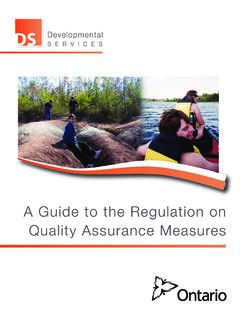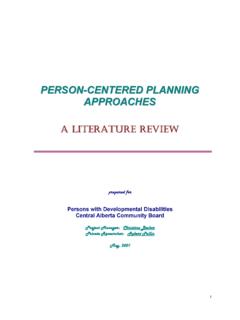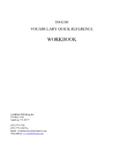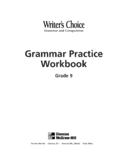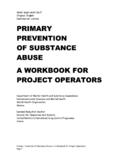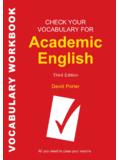Transcription of SELF-ADVOCACY MY LIFE - QAM Training
1 self -ADVOCACYMY LIFEWORKBOOKO ctober 2003 Acknowledgements The My life workbook was developed by Individuals with Developmental Disabilities in Central Alberta over the 2002-2003 period as part of their work in the Broadening Your Horizons project. Many individuals in the Wetaskiwin, Camrose, Wainwright and Red Deer areas assisted in the preparation of this workbook through their plain language suggestions, pilot use of the workbook , and through sharing their thoughts and ideas. Their contributions are gratefully acknowledged. The Persons with Developmental Disabilities (PDD) Central Alberta Community Board provided funding for the Broadening Your Horizons project and the work associated with this workbook . The workbook is based on the Quality of life standards that are part of the Creating Excellence Together certification process operated by the Alberta Association of Rehabilitation Centers (AARC).
2 AARC s support for this project is also gratefully acknowledged. My life workbook c 2003 PDD Central Alberta Community Board THIS IS MY life workbook By: _____ Date: _____ With Help From Mentor: _____ 1 self -Advocate workbook You can use this workbook to help you find out if you have the kind of life you want. It can also tell you what you can ask for to help make your life and the supports you get better. When agencies and PDD talk about how good your services and your life are, they use Creating Excellence Together (also called CET ) language. Agencies have to meet CET standards of good service to get money from PDD to help you. But the words in the CET standards are not always easy for self -advocates to read. This book was made by self -advocates for self -advocates. We put each CET standard into plain words, so more people can understand it.
3 There are lots of examples with each standard so you can see how it may relate to your life and the issues you face. You can fill out the workbook by yourself. Or you can get another self -advocate who is a mentor to help you fill it out. (A mentor is someone who knows more than you about what you want to learn. A mentor is there to help you.) After you have filled out the workbook , you can look at what you want to change in your life and make that happen. You can also use this workbook to tell agencies and your staff about quality of life issues that are important to you. This workbook was made by self Advocates who participated in the Broadening Your Horizons Project in Wetaskiwin and Wainwright, Alberta during 2002 and 2003. 2 About the workbook The workbook has 12 standards: 1. Homes I have a home. 2. Choices and Decision-making I make decisions about everyday matters.
4 3. Relationships I have strong, positive relationships. 4. Rights I am treated with dignity and respect. 5. Rights My rights are upheld. 6. Personal Control I have personal control. 7. Community inclusion I am included and participate in my community. 8. Work and Community Options If I choose to be employed, or participate in productive or skill learning activities, I have opportunities that are what I hoped for. 9. Leisure I enjoy my leisure time. 10. Health and Safety I take care of my health. 11. Health and Safety I am safe from physical harm. 12. Health and Safety I am free from abuse. If you think there are important things missing from the standards, please add them to the end of the workbook . 3 1. HOMES Standard #1: I have a home. I have the kind of home life I want. Examples: (Check the ones that are true for you.) - I decide where to live and with who. - I decide if I want to own my own home.
5 - I decide if I want to have personal space. - I have privacy. - I decide what to eat and when. - I decide when to go to bed and wake up. How I feel about my home life Examples of how my home fits my life : 10 9 8 7 6 5 4 3 2 1 4 2. CHOICES AND DECISION-MAKING Standard #2: I make decisions about everyday matters. I make decisions about daily things in my life . Examples: (Check the ones that are true for you.) - I decide what to wear. - I decide if and when I wash my hair and if and when I want to have a bath. - I decide what and when to eat. - I decide when to go to bed and wake up. - I decide if I want to go to work or not. - I decide how to spend my free time. - I have a say in making decisions. - I make decisions on my own without anyone changing them. - I ask for advice when I need it. - I get advice from parents or guardians to make good choices.
6 - I get advice from support staff to make good choices. - I am given real choices. Examples of decisions I make each day: 5 - I am given healthy opportunities or other choices. - I have control of my life . - I have the learning I need to make choices. - I can find out what I want to know from TV, radio, internet, newspapers or libraries. How I feel about the decisions I make in my life 10 9 8 7 6 5 4 3 2 1 6 3. RELATIONSHIPS Standard #3: I have strong, positive relationships. I have strong relationships with family, friends, staff and the community. Examples: (Check the ones that are true for you.) - I have good relationships with my family and parents. - I have good relationships with friends. - I have a good relationship with my roommate(s). - I have a good relationship with a girlfriend/boyfriend.
7 - I have good relationships with support workers/paid staff. - I have pets. - I have good relationships with community members (like police, doctor, fire dept., pharmacist). - I have good relationships with co-workers. - I have a good relationship with my employer. I also have a good relationship with 7 - I have relationships of my own free will. - I decide who my friends are. - I decide if I want to be married. - I get opportunities to make friends. - I am comfortable with my friends. - Staff read my body language, positive or negative, and don t push me. Examples of how others help me make friends: 10 9 8 7 6 5 4 3 2 1 How I feel about my relationships 8 4. RIGHTS Dignity and Respect Standard #4- I am treated with dignity and respect. I am treated the way I want to be treated. Examples: (Check the ones that are true for you.)
8 - People are nice to me. - I am not called names. - People talk to me and listen to me. - People smile and are happy around me. - People help me if I have a problem. - I am allowed to help out. - I am not ignored. - People treat me with trust and honesty. - I am treated equal/like everyone else. - I am taken seriously. Examples of how I am treated: 9 - People respect my choices. - I have privacy. - People keep my secrets as long as it doesn t harm me. Examples of how I want to be treated: How I feel about how others treat me 10 9 8 7 6 5 4 3 2 1 10 5. RIGHTS Rights are upheld Standard #5: My rights are upheld. I have the same rights as anyone Examples: (Check the ones that are true for you.) - I am part of the planning process. - I take part in decisions about me. - I decide if I want to learn about my rights and stand up for them.
9 - I know and understand my rights and what I must do (responsibility). - People treat me like anyone else. - I get to do things, like get a job or do leisure activities, just like everyone else. Examples of rights I have: 11 - My supporters listen and talk to me - allow me to say what I want to say. - My supporters do not holler at me, watch their temper and mouth, and keep their cool. - If something is bothering me, my supporters help make it better. - My supporters help me talk to people who don t treat me fairly. - My supporters treat me equally. - My supporters see that I m being treated the same as other people. - My supporters give me freedom to make choices. - My supporters make sure I know right and wrong. - My supporters make sure I know what I must do (my responsibility). - My supporters make sure I know how to be responsible. Examples of how my supporters help me with rights: How I feel about the rights I get 10 9 8 7 6 5 4 3 2 1 12 6.
10 PERSONAL CONTROL Standard #6: I have personal control. I can do what I want in my life Examples: (Check the ones that are true for you.) - I have control over myself. - I have control over what activities I want to do. - I have control over how I spend my money. - I have control over where I live. - I have control over decisions I make (like going to work, what to eat, where I work). - I have control over who I want as friends. - I have control over who I marry. - I learn new skills. - I decide whether to make changes in my life or not. - People listen when I have something to say. - I feel better and better about myself every day. - I am treated equal. How I feel about how much control I have Examples of what I have control over: 10 9 8 7 6 5 4 3 2 1 13 7. COMMUNITY INCLUSION Standard #7: I am included and participate in my community.
